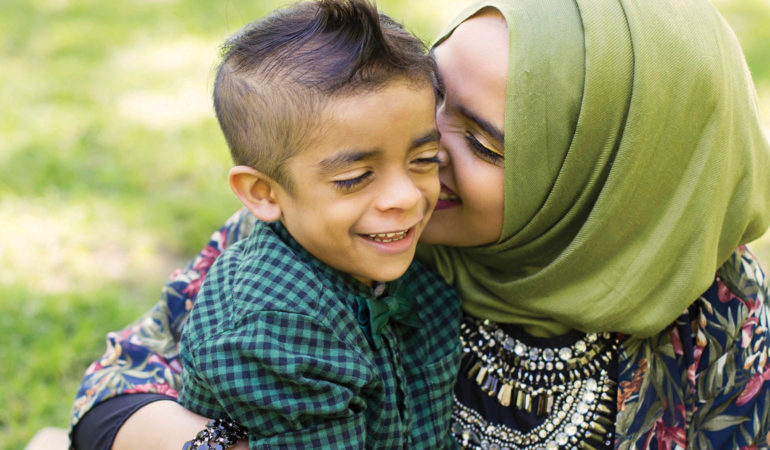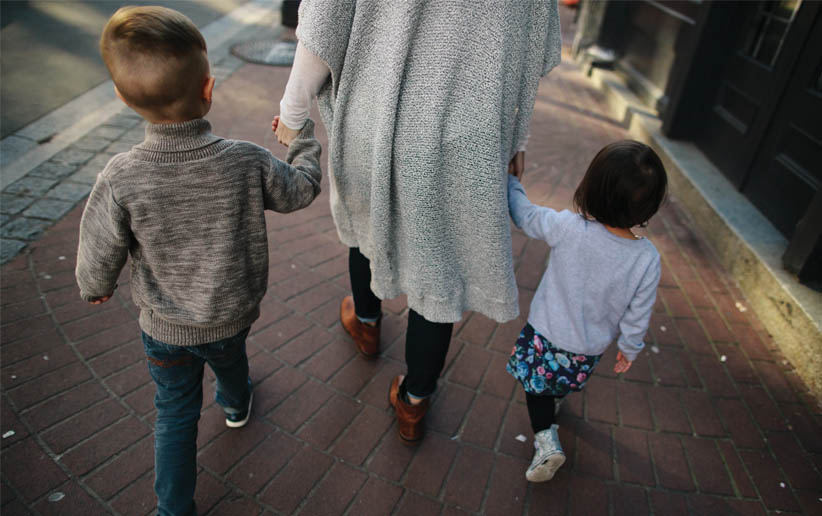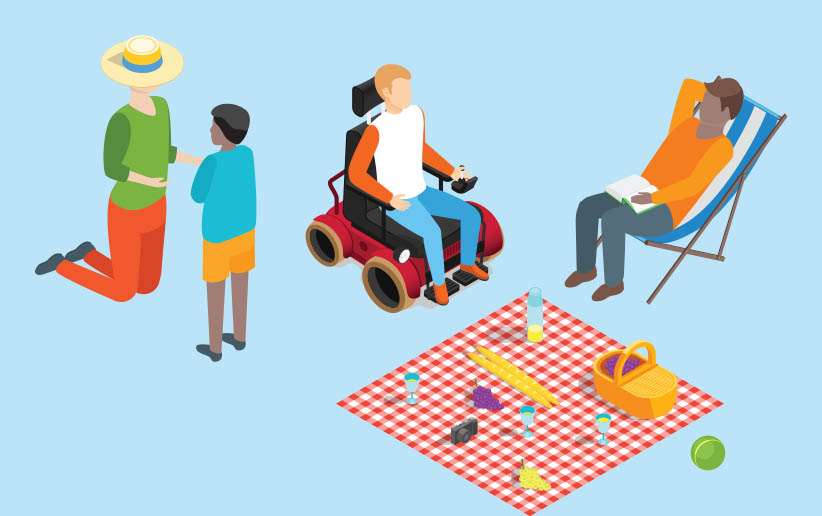The U.S. prevalence of families who are impacted by a disability has been steadily increasing in recent years. According to recent U.S. Census Bureau (2019) data, approximately 13% of non-institutionalized adults have a reported disability that interferes with their ability to function independently and to perform activities of daily living such as driving, self-care, household chores, and working. Likewise, the Centers for Disease Control report that one in six (17%) children in the U.S. have a developmental disability, which demonstrates a steady increase over the last 10 years (Zablotsky et al., 2019).
The majority of adults and children with disabilities receive support for their daily living from a family caregiver. As such, families are and will continue to be the largest providers of care and support for individuals with disabilities in the United States (Larson et al., 2015). Because family members play an integral role in meeting the needs of individuals with disabilities, promoting family resilience has strong implications for health and wellbeing of all family members.
Despite the widespread acknowledgement of the importance of families in quality of life for people with disabilities, there is a concerning lack of guidance to define and identify best practices and policy for effectively supporting families (Burke, Lulinski, Jones, & Gallus, 2018; Hewitt, Agosta, Heller, Williams, & Reinke, 2013).
The practice of marriage and family therapy (MFT) inherently assumes the interdependence between personal and relational functioning as influenced by contextual factors. This clinical framework suggests M/CFTs are ideally trained to meet the unique needs of families of people with disabilities, Yet, the majority of MFT training curricula do not routinely address clinical training or supervision related to disabilities. As a result, many M/CFTs consider therapy with families impacted by disabilities as outside their scope of practice. Systemically informed professionals have an opportunity to play a key role in bridging the gap to address the growing need for accessible mental health services that support individuals with disabilities and their families by managing risks and enhancing resilience.
Individual and relational outcomes
While some families and relationships of individuals with disabilities develop strong coping strategies to function quite well (Bayat, 2007), research also illustrates that unique challenges can negatively affect the health and wellbeing of many families (Brown, Anand, Alan-Fung, Isaacs, & Baum, 2003; Greenberg, Seltzer, & Greenley 1993; Jokinen & Brown, 2011). Due to the added caregiving responsibilities that are necessary for individuals with disabilities, members of families affected by disabilities have an increased prevalence of physical, psychological, and relational distress (Brown, Whiting, Kahumoku-Fessler, Banford Witting, & Jensen, 2020; Pilapil, Coletti, Rabey, & DeLaet, 2017). Parents, spouses, and siblings of children with disabilities experience higher rates of mental health concerns such as anxiety and depression when compared to families of typically developing children (Marquis, McGrail, & Hayes, 2020). Caregivers in particular have higher rates of health problems and report a variety of physical symptoms like migraines, heart conditions, and sleep problems (Lee, Park, Matthews, & Hsieh 2017). These mental and physical health effects lead to reports of decreased quality of life and general wellbeing (Arora, Goodall, Viney, Einfeld, & the MHYPEDD team, 2020; Pilapil et al., 2017).
 In addition to the physical and psychological outcomes of individual family members, families affected by disabilities are also affected by greater relational concerns. Parents of children with developmental disabilities face difficult and unique challenges to meet the needs of a child with a disability, which leads to greater marital and relational strain. Previous reports that suggested nearly 80% divorce rates among parents of children with disabilities have been shown to be misleading, as there are differences according to family size and child development stage. However, there is still a disproportionately high divorce rate among parents of children with a disability compared to parents of typically developing children when number of children was comparable (Namkung et al., 2015).
In addition to the physical and psychological outcomes of individual family members, families affected by disabilities are also affected by greater relational concerns. Parents of children with developmental disabilities face difficult and unique challenges to meet the needs of a child with a disability, which leads to greater marital and relational strain. Previous reports that suggested nearly 80% divorce rates among parents of children with disabilities have been shown to be misleading, as there are differences according to family size and child development stage. However, there is still a disproportionately high divorce rate among parents of children with a disability compared to parents of typically developing children when number of children was comparable (Namkung et al., 2015).
While parenting and co-parenting a child with a disability poses significant challenges, couples in which one or both partners has a disability also face unique relational difficulties. A growing area of clinical interest is dedicated to exploring couple therapy approaches that are appropriate for addressing the unique needs of adults with disabilities. Romantic partners of individuals with a disability experience similar trends in mental and physical health decline as parents. For example, neurotypical partners of people with Autism Spectrum Disorder (ASD) experience physical health decline, negative self-image, and a profound loss of hope (Bostock-Ling, Cumming, & Bundy 2012; Lewis, 2017). Couple therapy approaches should address discrepancies in relationship expectations for adults with a disability and their romantic partners, as inconsistent relational expectations are associated with unmet emotional needs and poor relationship satisfaction (Parker & Mosley, In Press; Strunz et al., 2017).
Social support
Many of the adverse physical, mental, and relational health effects described by family members of individuals with disabilities are compounded by a lack of social support. Families often explain that there is a notable deficit in available social support, which they generally attribute to two main reasons: 1) family members’ lack of free time to socialize with friends and family due to the added caregiving responsibilities, or 2) societal stigma associated with disabilities that may be attributed to personal shame and embarrassment of family members or the disapproval and ostracization by others (Recio, Molero, Garcia-Ael, & Perez-Garin, 2020). Unsurprisingly, caregivers of individuals with intellectual and developmental disabilities were disproportionately affected by the social distancing measures implemented during the recent COVID-19 pandemic. Not only were caregivers unable to access their already strained social supports, professional support services were also significantly reduced due to school and professional clinic closures (Chung, 2020; Willner et al., 2020). An unexpected outcome of the pandemic has been a surge in research that demonstrates promising findings in the evaluation of online platforms (e.g., Facebook) as a means of social support for caregivers. Clinicians working with families affected by disabilities can support caregivers by connecting them with appropriate online platforms to increase social support, which acts as a protective factor against the harmful effects of caregiver stress and burnout.
Although having a family member with a disability may result in greater demands on family resources, the presence of family coping strategies, social support, and community resources can effectively reduce the stress associated with having a loved one with a disability (Asberg, Vogel, & Bowers, 2007). Research indicates that access to social support and interventions that promote adaptation to meet everyday challenges helps families mitigate many of the negative effects often noted as outcomes in family research (Caldwell, Jones, Gallus, & Henry, 2018; Jones & Gallus, 2016; McConnell & Savage, 2015).
Despite the additional obstacles and challenges, parents also describe positive outcomes, such as patience, compassion, and family cohesion amidst the overwhelming struggles of caring for a child with a disability (Sim, Cordier, Vaz, & Falkmer, 2019). Greater resiliency is noted among families that are able to ascribe a positive meaning to adversity or seek the benefits of caring for a family member with a disability. It is therefore essential for M/CFTs to consider ways to identify and build on families’ strengths and inherent competence to overcome the challenges they face.
Greater resiliency is noted among families that are able to ascribe a positive meaning to adversity or seek the benefits of caring for a family member with a disability.
Contextual influences and intersectionality
The conceptualization of intersectionality (Crenshaw, 1989) enables a complex understanding of the ways in which race, gender, class, sexuality, ability and other dimensions of social, cultural, and economic determinants intersect to shape daily life and social structures. Disabilities are an important, albeit often overlooked, representation of diversity and contextual considerations. Varied abilities and needs among individuals with disabilities are associated with differences in the experiences and challenges families encounter across the lifespan. As such, identifying associated contextual and social factors is critical for clinicians to conceptualize the impact of disability on individuals and families. However, the intersection of disability with other important sociodemographic factors are often overlooked. Due to diagnostic overshadowing of disabilities over other key elements, individuals with disabilities and their families are frequently assumed to share the same experiences, needs, and strengths regardless of gender, age, religion, socio-economic status or other determinants (Goethals, De Schauwer, & Van Hove, 2015).
Families of those with disabilities broadly experience financial strain due to added medical expenses and difficulty maintaining full-time employment outside of the home (Liu, Dokos, Fauth, Lee, & Zarit, 2019). The loss of income has a different impact on families according to other contextual factors that influence access to treatment. Families that maintain access to the necessary disability treatments despite the loss of income experience far fewer adverse outcomes in personal and relational functioning. Marginalized and underserved populations, such as racial/ethnic minority families or those living in rural communities, often experience even greater negative effects of caregiving due to lack of appropriate resources. For example, Hispanic and African-American youth are more likely to receive the appropriate frequency of necessary treatments if they are school-based (as opposed to healthcare clinics) services (Siller, Reyes, Hotez, Hutman, & Sigman, 2014). However, schools that are located in rural communities have fewer school-based services and are often deemed by the U.S. Health Resource and Services Administration as Health Professional Shortage Areas. Therefore, individuals with disabilities living in rural communities experienced disproportionately higher rates of unmet treatment needs (Karpur, Lello, Frazier, Dixon, & Shih, 2019). There is an opportunity for MFTs to support families who are disproportionately affected by disabilities by engaging in an expanding body of disability treatment research related to care coordination.
Coordinating care
Recent U.S. trends in disability-related specialty care, which we will discuss in further detail, are strongly associated with negative effects among family members by further limiting access to appropriate providers (Parker & Killian, 2020). In addition to providing routine support for daily living, family members of individuals with disabilities also assume a primary role in advocating for and accessing appropriate supports and services (e.g., education, transportation, healthcare). Among the common barriers to accessing effective supports and services for individuals with disabilities are the availability and affordability of care (Douma, Dekker, & Koot, 2006; Krauss, Gulley, Sciegaj, Wells, & Taylor, 2003).
The American Academy of Pediatrics (2014) has proposed that care coordination is a vital service that improves access to multi-provider treatments and supports the added challenges that family members of people with disabilities face. There are various, specialized disciplines that are focused on addressing the medical (e.g., neurology), psychological (e.g., applied behavior analysis), and educational (e.g., special education) needs associated with disabilities. The growing trend toward decentralization of these disability subspecialties further limits access to treatment providers for many patients. Families must endure increasingly long wait periods for appointments and are often required to drive long distances to attend appointments. In extreme, but not uncommon circumstances, some treatments may not be available at all due to the growing number of healthcare provider shortage areas in the United States that disproportionately affect individuals with disabilities (Martinez et al., 2018). Barriers to accessing appropriate supports and services place an excessive burden on family resources (i.e., financial, time) that are strongly associated with adverse effects to caregivers’ mental and physical wellbeing (Pilapil et al., 2017; Parker et al., 2020).
Additional resource: Therapy Outcomes for Neurodiverse Couples: Exploring a Solution-focused Approach. Michele L. Parker and Marissa A. Mosley
In addition to these notable difficulties with treatment accessibility, disability specialists inherently assume a pathological stance of the individual patient consistent with the medical model and rarely, if ever, consider the needs of family members. As M/CFTs are trained in collaborative care with other treatment providers, there is an opportunity for our profession to meet a growing need for this underserved population.
 Marriage, couple, and family therapists are necessary to meet the needs of underserved families and couples experiencing the contextual and social influences affecting those with disabilities. Cultural competence and humility represent a key skill set of M/CFTs who are highly trained and well-equipped to facilitate connection with clients across diverse backgrounds. It is important to remember that cultural competence represents more than a professional skill set; it is a professional’s personal and ongoing desire and commitment to use those skills to understand diverse client experiences. While more research on the needs of individuals with disabilities and their families is needed to advance training of systemic therapists, the unmet needs facing individuals with disabilities and their families simply cannot wait for research and education to catch up. We propose that M/CFTs must be willing to answer the current call to work alongside individuals with disabilities and their families as a vital step in advancing the profession and addressing the ongoing disparities many individuals with disabilities and their families face.
Marriage, couple, and family therapists are necessary to meet the needs of underserved families and couples experiencing the contextual and social influences affecting those with disabilities. Cultural competence and humility represent a key skill set of M/CFTs who are highly trained and well-equipped to facilitate connection with clients across diverse backgrounds. It is important to remember that cultural competence represents more than a professional skill set; it is a professional’s personal and ongoing desire and commitment to use those skills to understand diverse client experiences. While more research on the needs of individuals with disabilities and their families is needed to advance training of systemic therapists, the unmet needs facing individuals with disabilities and their families simply cannot wait for research and education to catch up. We propose that M/CFTs must be willing to answer the current call to work alongside individuals with disabilities and their families as a vital step in advancing the profession and addressing the ongoing disparities many individuals with disabilities and their families face.
This article is offered free by AAMFT. If you are interested in accessing other content, join today!
Families that maintain access to the necessary disability treatments despite the loss of income experience far fewer adverse outcomes in personal and relational functioning.

M. L. Parker, PhD, LMFT, is an AAMFT Clinical Fellow and Approved Supervisor. She is currently an assistant professor at Florida State University. Parker is also a research faculty at the FSU Multidisciplinary Center, which provides assessment and treatment services for families of children with complex medical, educational, and emotional/behavioral diagnoses. Her research focuses on collaborative healthcare practices and health disparities among individuals with Autism Spectrum Disorder.

Kami L. Gallus, PhD, LMFT, is an AAMFT Clinical Fellow and Approved Supervisor. She is a professor and co-director of the Institute for Developmental Disabilities at Oklahoma State University. Gallus’ scholarship focuses on enhancing individual functioning, belonging, and relationship outcomes among vulnerable, often marginalized, and traditionally under-served populations, including female trauma survivors, at-risk youth, and individuals with intellectual and developmental disabilities.
REFERENCES
American Academy of Pediatrics. (2014). Patient and family centered care coordination: A framework for integrating care for children and youth across multiple systems. Pediatrics, 133(5), 1451-1460.
Arora, S., Goodall, S., Viney R., Einfeld, S., & the MHYPEDD team. (2020). Health-related quality of life amongst primary caregivers of children with intellectual disabilities. Journal of Intellectual Disability Research, 64. 103-116. doi: 10.1111/jir.12701
Asberg, K. K., Vogel, J. J., & Bowers, C. A. (2007). Exploring correlates and predictors of stress in parents of children who are deaf: Implications of perceived social support and mode of communication. Journal of Child and Family Studies, 17(4), 486–499. doi:10.1007/s10826-007-9169-7
Bayat, M. (2007). Evidence of resilience in families of children with autism. Journal of Intellectual Disability Research, 51(9), 702-714. doi:10.1111/j.1365-2788.2007.00960.x
Bostock-Ling, J., Cumming, S., & Bundy, A. (2012). Life satisfaction of neurotypical women in intimate relationship with an Asperger’s syndrome partner: A systematic review of the literature. Journal of Relationships Research, 3. 95-105.
Brown, I., Anand, S., Alan-Fung, W. L., Isaacs, B., & Baum, N. (2003). Family quality of life: Canadian results from an international study. Journal of Developmental and Physical Disabilities, 15, 207-229. http://dx.doi.org/10.1023/A:1024931022773
Brown, M., Whiting, J., Kahumoku-Fessler, E., Banford Witting, A., & Jensen, J. (2020). A dyadic model of stress, coping, and marital satisfaction among parents of children with autism. Family Relations, 69. 138 – 150. https://doi.org/10.1111/fare.12375
Burke, M. M., Lulinski, A., Jones, J. L., & Gallus, K. L. (2018). A review of supports and services for adults with intellectual and developmental disabilities (IDD) and their families in the United States: Past and present contexts impacting future research, practice and policy. In M. Burke (Series Ed.), International Review of Research in Developmental Disabilities: Volume 54. Service delivery systems for individuals with intellectual and developmental disabilities and their families across the lifespan (pp. 137-176). http://dx.doi.org/10.1016/bs.irrdd.2018.07.005
Caldwell, J. A. Jones, J. L., Gallus, K. L., & Henry, C. S. (2018). Empowerment and resilience in families of adults with intellectual and developmental disabilities. Intellectual and Developmental Disabilities, 56(5), 374-388. http://dx.doi.org/10.1352/1934-9556-56.5.374
Chung, W. (2020). Impact of COVID-19 on families and children with autism. Simons Foundation Powering Autism Research for Knowledge (SPARK).
Crenshaw, K. (1989). Demarginalizing the intersection of race and sex: A black feminist critique of antidiscrimination doctrine, feminist theory and antiracist politics. University of Chicago Legal Forum, 139–168. Retrieved from http://chicagounbound.uchicago.edu/uclf/vol1989/iss1/8
Douma, J., Dekker, M., & Koot, H. (2006). Supporting parents of youths with intellectual disabilities and psychopathology. Journal of Intellectual Disability Research, 50, 570-581. https://doi.org/10.1111/j.1365-2788.2006.00825.x
Goethals, T., De Schauwer, E. & Van Hove, G. (2015). Weaving intersectionality into disability studies research: Inclusion, reflexivity and anti-essentialism. Journal of Diversity and Gender Studies, 2(1-2), 75-94. doi:10.11116/jdivegendstud.2.1-2.0075
Greenberg, J. S., Seltzer, M. M., & Greenley, J. R. (1993). Aging parents of adults with disabilities: The gratifications and frustrations of later-life caregiving. The Gerontologist, 33, 542-550. http://dx.doi.org/10.1093/geront/33.4.542
Hewitt, A., Agosta, J., Heller, T., Williams, A. C., & Reinke, J. (2013). Families of individuals with intellectual and developmental disabilities: Policy, funding, services, and experiences. Intellectual and Developmental Disabilities, 51(5), 349-359. http://dx.doi.org/10.1352/1934-9556.51.5.349
Jokinen, N. S., & Brown, R. I. (2011). Family quality of life and older-aged families of adults with an intellectual disability. In R. Kober (Ed.), Enhancing the quality of life of people with intellectual disabilities: From theory to practice (pp. 279-303). Berlin, Germany: Springer.
Jones, J. L., & Gallus, K. L. (2016). Understanding deinstitutionalization: What families value and desire in the transition to community living. Research and Practice for Persons with Severe Disabilities, 41(2), 116-131. http://dx.doi.org/10.1177/15407996916637050
Karpur, A., Lello, A., Frazier, T., Dixon, P., & Shih, A. (2019). Health disparities among children with autism spectrum disorders: Analysis of the National Survey of Children’s Health 2016. Journal of Autism and Developmental Disorder, 49. 1652-1664.
Krauss, M., Gulley, S., Sciegaj, M., Wells, N., & Taylor, S. (2003). Access to specialty medical care for children with mental retardation, Autism, and other special health care needs. Intellectual and Developmental Disabilities, 42, 329-339. https://doi.org/10.1352/00476765(2003)41<329:ATSMCF>2.0.CO;2
Larson, S. A., Eschenbacher, H. J., Anderson, L. L., Taylor, B., Pettingell, S., Hewitt, A., Bourne, M. L. (2017). In-home and residential long-term supports and services for persons with intellectual or developmental disabilities: Status and trends through 2015. University of Minnesota, Research and Training Center on Community Living, Institute on Community Integration. Retrieved from https://icis.umn.edu/files/aCHyYaFjMi/risp_2017
Lee M., Park C., Matthews A., & Hsieh K. (2018). Differences in physical health, and health behaviors between family caregivers of children with and without disabilities. Disability and Health Journal, 10. 565-570. doi: 10.1016/j.dhjo.2017.03.007.
Lewis, L. (2017). “We will never be normal”: The experience of discovering a partner has autism spectrum disorder. Journal of Marital and Family Therapy, 43. 631-643. doi: 10.1111/jmft.12231
Liu, Y., Dokos, M., Fauth, E., Lee, Y., & Zarit, S. (2019). Financial strain, employment, and role captivity and overload over time among dementia family caregivers. Genontologist, 59. 512-520.
Marquis, S., McGrail, K., & Hayes, M. (2020). Mental health outcomes among parents of a child who has a developmental disability: Comparing different types of developmental disability. Disability and Health Journal, 13. https://doi.org/10.1016/j.dhjo.2019.100874
Martinez, M., Thomas, K., Williams, C., Christian, R., Crais, E., Pretzel, R., Hooper, S. (2018). Family experiences with the diagnosis of autism spectrum disorder: System barriers and facilitators of efficient diagnosis. Journal of Autism and Developmental Disorders, 48. 2368-2378.
McConnell, D. & Savage, A. (2015). Stress and resilience among families caring for children with intellectual disability: Expanding the research agenda. Current Developmental Disorders Reports, 2, 100-109. http://dx.doi.org/10.1007/s40474-015-0040-z
Namkung, E., Song, J., Greenberg, J., Mailick, M., & Floyd, F. (2015). The relative risk of divorce in parents of children with developmental disabilities: Impacts of lifelong parenting. American Journal on Intellectual and Developmental Disabilities, 120. 514-526.
Parker, M. L. & Killian, M. (2020). Autism spectrum disorder and complex healthcare needs: The role of healthcare experiences. Research in Autism Spectrum Disorders, 73.
Parker, M. L. & Mosley, M. (In Press). Therapy outcomes for neurodiverse couples: Evaluating a solution-focused approach. Journal of Marital and Family Therapy.
Pilapil, M., Coletti, D., Rabey, C., & DeLaet, D. (2017). Caring for the caregiver: Supporting families of youth with special health care needs. Current Problems in Pediatric and Adolescent Health Care, 47. 190-199.
Recio, P., Molero, F., Garcia-Ael, C. & Perez-Garin, D.(2020). Perceived discrimination and self-esteem among family caregivers of children with autism spectrum disorders and intellectual disabilities in Spain: The mediational role of affiliate stigma and social support. Research in Developmental Disabilities, 105. https://doi.org/10.1016/j.ridd.2020.103737
Siller, M., Reyes, N., Hotez, E., Hutman, T., & Sigman, M. (2014). Longitudinal change in the use of services in autism spectrum disorder: Understanding the role of child characteristics, family demographics, and parent cognitions. Autism, 18. 433-446.
Sim, A., Cordier, R., Vaz, S., & Falkmer, T. (2019). “We are in this together”: Experiences of relationship satisfaction in couple raising a child with autism spectrum disorder. Research in Autism Spectrum Disorders, 58. 39-51.
Strunz, S., Schermuck, C., Ballerstein, S., Ahlers, C., Dziobeck, I., & Roepke, S. (2017). Romantic relationships and relationship satisfaction among adults with Asperger syndrome and high-functioning autism. Journal of Clinical Psychology, 73. 113-125. doi: 10.1002/jclp.22319
U.S. Census Bureau. (2019). 2015-2019 American Community Survey 5-Year Data Profile. Retrieved from https://data.census.gov/cedsci/table?d=ACS%205-Year%20Estimates%20Data%20Profiles&tid=ACSDP5Y2019.DP02
Willner, P., Rose, J., Kroese, B., Murphy, G., Langdon, P., Clifford, C., Hutchins, H., Watkins, A., Hiles, S., & Cooper, V. (2020). Effect of the COVID-19 pandemic on the mental health of carers of people with intellectual disabilities. Journal of Applied Research in Intellectual Disabilities, 33. 1523-1533.
Zablotsky, B., Black, L. I., Maenner, M. J., Schieve, L. A., Danielson, M. L., Bitsko, R. H., Blumberg, S. J., Kogan, M. D., & Boyle, C. A. (2019). Prevalence and trends of developmental disabilities among children in the US: 2009-2017. Pediatrics, 144.
Other articles
“How come no one can help us?” How MFTs Can Begin Treating Families with a Disability
Parents, partners, siblings, and extended family members are all impacted by a disability and struggle with adapting to the various challenges and behaviors. MFTs are specifically trained to treat the relationships within a family and the larger community.
Brie Turns, PhD and Paul Springer, PhD
Top 5 Favorite Interventions for Treating a Family with a Disability
Working with families living with a disability can often feel overwhelming for beginning and seasoned clinicians. Discover these five easily adaptable interventions for treating a family living with a physical, intellectual, or developmental disability.
Brie Turns, PhD and Paul Springer, PhD
Disability and Stigma
Disability is often perceived by society as a negative experience and something unwanted. As systemic therapists, we are accountable for our stigmas and biases towards disabled clients and their families.
Briana Mills, MSFT



